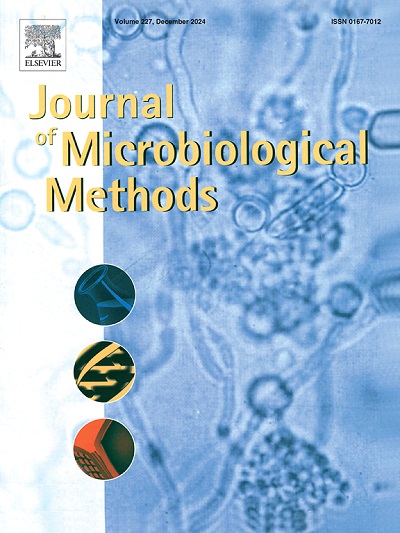Engineering of a monitorable expression system to characterize β-lactamase genes in Enterobacteriaceae
IF 1.7
4区 生物学
Q4 BIOCHEMICAL RESEARCH METHODS
引用次数: 0
Abstract
Bacteria are becoming progressively more resistant to available antimicrobials. The increased ease and availability of genome sequencing has made it possible to identify putative, novel antimicrobial resistance (AMR) genes bioinformatically. However, no standardized system is available to phenotypically characterize the ability of novel AMR genes in Enterobacteriaceae to confer resistance and impact bacterial physiology and pathogenicity in relation to expression levels. We previously used plasmid pBAD24, which allows for arabinose-inducible expression of heterologous genes, and Escherichia coli Top10 to characterize mobile colistin resistance genes. Based on the pBAD24 backbone, we constructed a new plasmid (pBAD25) that carries a kanamycin resistance gene (instead of an ampicillin resistance gene). We show that our expression system allows for the characterization of five different blaOXA genes, which differ in their ability to confer susceptibility to β-lactams, detected protein levels, and impact on bacterial growth. We characterized blaOXA-48b, a close relative of blaOXA-48, previously uncharacterized in E. coli, to be phenotypically similar to blaOXA-48, and blaOXA-549, a previously uncharacterized gene of the blaOXA-548 family, as encoding a β-lactamase that is detected intra- but not extracellularly, has moderate growth defects, and decreases susceptibility to carbapenems and ampicillin. Additionally, we found that, in blaOXA expressing strains, (i) levels of intracellular proteins and bacterial growth negatively correlate and (ii) susceptibility to 2nd and 3rd generation cephalosporins and susceptibility to different carbapenems positively correlate. Our results demonstrate that the expression of AMR genes, specifically blaOXA genes, through pBAD25 allows for easy characterization of putative, novel AMR genes.
肠杆菌科β-内酰胺酶基因可监测表达系统的工程设计。
细菌对现有抗菌剂的耐药性正在逐渐增强。基因组测序的便利性和可获得性的增加使得从生物信息学上鉴定假定的新型抗菌素耐药性(AMR)基因成为可能。然而,目前还没有标准化的系统来表型表征肠杆菌科新型AMR基因赋予耐药性和影响细菌生理和致病性与表达水平相关的能力。我们之前使用质粒pBAD24,它允许阿拉伯糖诱导表达外源基因,以及大肠杆菌Top10来表征移动粘菌素抗性基因。基于pBAD24骨架,我们构建了一个新的质粒pBAD25,该质粒携带卡那霉素耐药基因(而不是氨苄西林耐药基因)。我们表明,我们的表达系统可以表征五种不同的blaOXA基因,这些基因在赋予β-内酰胺易感性的能力、检测到的蛋白水平和对细菌生长的影响方面存在差异。我们发现blaOXA-48b是blaOXA-48的近亲,以前在大肠杆菌中未被发现,其表型与blaOXA-48相似,blaOXA-549是blaOXA-548家族的一个以前未被发现的基因,编码一种β-内酰胺酶,这种酶在细胞内检测到,但在细胞外检测不到,具有中等的生长缺陷,并降低对碳青霉烯类和氨苄西林的敏感性。此外,我们发现,在表达blaOXA的菌株中,(i)细胞内蛋白水平与细菌生长呈负相关,(ii)对第二代和第三代头孢菌素的易感性与对不同碳青霉烯类药物的易感性呈正相关。我们的研究结果表明,通过pBAD25表达AMR基因,特别是blaOXA基因,可以很容易地表征推定的新型AMR基因。
本文章由计算机程序翻译,如有差异,请以英文原文为准。
求助全文
约1分钟内获得全文
求助全文
来源期刊

Journal of microbiological methods
生物-生化研究方法
CiteScore
4.30
自引率
4.50%
发文量
151
审稿时长
29 days
期刊介绍:
The Journal of Microbiological Methods publishes scholarly and original articles, notes and review articles. These articles must include novel and/or state-of-the-art methods, or significant improvements to existing methods. Novel and innovative applications of current methods that are validated and useful will also be published. JMM strives for scholarship, innovation and excellence. This demands scientific rigour, the best available methods and technologies, correctly replicated experiments/tests, the inclusion of proper controls, calibrations, and the correct statistical analysis. The presentation of the data must support the interpretation of the method/approach.
All aspects of microbiology are covered, except virology. These include agricultural microbiology, applied and environmental microbiology, bioassays, bioinformatics, biotechnology, biochemical microbiology, clinical microbiology, diagnostics, food monitoring and quality control microbiology, microbial genetics and genomics, geomicrobiology, microbiome methods regardless of habitat, high through-put sequencing methods and analysis, microbial pathogenesis and host responses, metabolomics, metagenomics, metaproteomics, microbial ecology and diversity, microbial physiology, microbial ultra-structure, microscopic and imaging methods, molecular microbiology, mycology, novel mathematical microbiology and modelling, parasitology, plant-microbe interactions, protein markers/profiles, proteomics, pyrosequencing, public health microbiology, radioisotopes applied to microbiology, robotics applied to microbiological methods,rumen microbiology, microbiological methods for space missions and extreme environments, sampling methods and samplers, soil and sediment microbiology, transcriptomics, veterinary microbiology, sero-diagnostics and typing/identification.
 求助内容:
求助内容: 应助结果提醒方式:
应助结果提醒方式:


